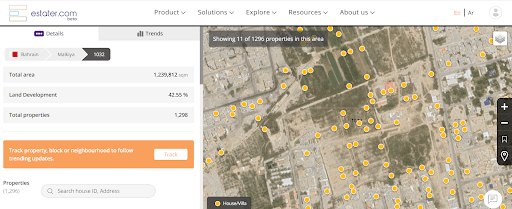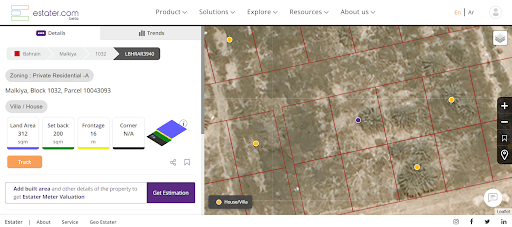
TECH
used
Figma
Miro
our
impact
600+
pages indexed in 90 days
4 weeks
for product to go live
The real estate sector in the Gulf Cooperation Council (GCC) countries, has long been a cornerstone of economic growth. Despite its prominence, the industry has remained largely traditional in its operations. This, combined with the region's ambition and rapid development, made the sector ripe for innovation.
Enter Estater, GCC’s leading proptech firm. Established in 2009 by Mahmoud AlJarrah, Roobesh Modi, and Sanjay Goyal, the company sought to change the way real estate operated.
Using Geographic Information System (GIS) and data science, they developed the Estater Meter, a tool designed to transform the traditional approach to property valuation. Gone were the days when property evaluation meant site visits, manual checks, and lengthy processes. With Estater Meter, users could leverage spatial data to instantly estimate property values, analyze market trends, and make informed decisions, all with a few clicks.
But Estater's vision went beyond just property valuation. By integrating various data sources, from demographics to zoning, the platform provided a comprehensive view of the market. Whether it was identifying potential investment opportunities, optimizing site selection for real estate projects, or analyzing market dynamics, Estater became the go-to solution for real estate professionals in the GCC.
As of 2023, Estater is the only company to possess comprehensive Geographic Information System (GIS) data for the entire GCC region. Their meticulous approach considers an impressive array of over 100 property features to ascertain accurate valuations. Their database now encompasses around 2 million properties, with several hundred million calculations incoming.
As Estater looked to further refine and amplify the capabilities of their platform, they recognized the need for a fresh approach.
This is where we, at Cyces, stepped in. We proposed a collaborative effort to reimagine the Estater Meter through a design sprint.
Our goal was clear: to iterate and enhance the Estater Meter, making it more user-friendly, versatile, and ready for its relaunch in the markets of Bahrain, Kuwait, and Riyadh.
We adopted a structured five-day design sprint, a methodology that condenses months of work into days, emphasizing rapid prototyping and user testing. This approach allowed us to swiftly move from understanding the challenges to implementing solutions.
Our team embarked on an exhaustive exploration of the GCC real estate market. This wasn't just about gathering data but interpreting it to draw actionable insights. We sought to understand the prevailing market dynamics, identify the challenges users frequently encountered, and recognize the untapped opportunities that Estater could potentially address. This laid the groundwork for the subsequent phases of our design sprint.
Engaging directly with the market's primary players was pivotal. We organized structured interviews with property owners, brokers, and other key stakeholders. These dialogues provided us with invaluable firsthand insights.
No product can succeed without a clear understanding of its target audience. We dedicated time and resources to craft a detailed Ideal Customer Profile (ICP). This exercise went beyond mere demographics. We delved into behavioral patterns, pain points, and aspirations of the potential users to ensure that our strategies and solutions align perfectly with their core needs.
User experience is paramount. With the insights gathered, we meticulously designed a product flow that promised intuitive and frictionless interaction. Every step, from the user's entry point to their final interaction, was mapped out, ensuring clarity, simplicity, and efficiency.
Thanks to the interviews and the ICP research, we suggested the product has three tracks: Value, Track and Trend.

Value
Ideal Profile: Homeowners, property sellers, or even potential buyers who are looking for a quick, hassle-free estimation of a property's worth. This could range from someone considering selling their home and wanting to understand its market value, to a buyer wanting to ensure they're getting a fair deal.
Why This Feature Matters: Property valuation has traditionally been a complex process, often requiring professional assessments, site visits, and a considerable amount of time. The "Value" track simplifies this. By leveraging machine learning, Estater offers instant, accurate estimations. This empowers users to make swift decisions, whether they're contemplating selling, buying, or simply curious about their property's current market value.
Track
Ideal Profile: Real estate investors, property owners, or individuals keen on staying informed about a particular location or their property's status. This could be someone who has invested in multiple properties and needs to monitor their value or someone considering investing in a particular area and wants real-time data.
Why This Feature Matters: The real estate market is dynamic, with property values and location desirability often shifting due to various factors. The "Track" feature provides users with real-time updates, ensuring they're never out of the loop. Whether it's a sudden development in a location or a shift in property values, users are always informed, allowing them to make timely decisions or adjustments to their real estate strategies.
Trend
Ideal Profile: Real estate professionals, market analysts, or investors who require comprehensive market insights to make informed decisions. This could be a realtor wanting to understand market dynamics to advise clients better, an analyst studying market patterns, or an investor scouting for the next big opportunity.
Why This Feature Matters: In the competitive realm of real estate, staying ahead requires more than just surface-level information. The "Trend" track offers in-depth market trend reports, providing granular insights on pricing, construction, and occupancy. With real-time alerts on market shifts, professionals can strategize proactively, ensuring they're always a step ahead in the market. This track essentially becomes a powerful tool for strategic planning and forecasting, crucial for professionals aiming for market leadership.
We also had to ensure that we set up a stable, scalable SEO framework, considering the hundreds of pages that were supposed to go live.
Traditional SEO gets you visibility; product-led SEO ensures engagement. Our strategy was to ensure that organic visitors, drawn by our SEO efforts, found genuine value in Estater's offerings. By integrating insightful content with Estater's core services, we aimed to transform casual visitors into loyal, engaged users.

(Image shows GIS data of the block 1032, in Malkiya region of Bahrain)
Users can also zoom into a particular property, as shown in the image below:

The design sprint culminated in a redefined Estater Meter, optimized for both user experience and market demands. Early feedback from stakeholders and adopters was overwhelmingly positive, highlighting the tool's enhanced usability and features. Quantitatively, the sprint resulted in improved user engagement metrics and a notable boost in SEO rankings, cementing Estater's digital presence.
SERVICES
OFFERED
FROM
THEM
The design sprint culminated in a redefined Estater Meter, optimized for both user experience and market demands.